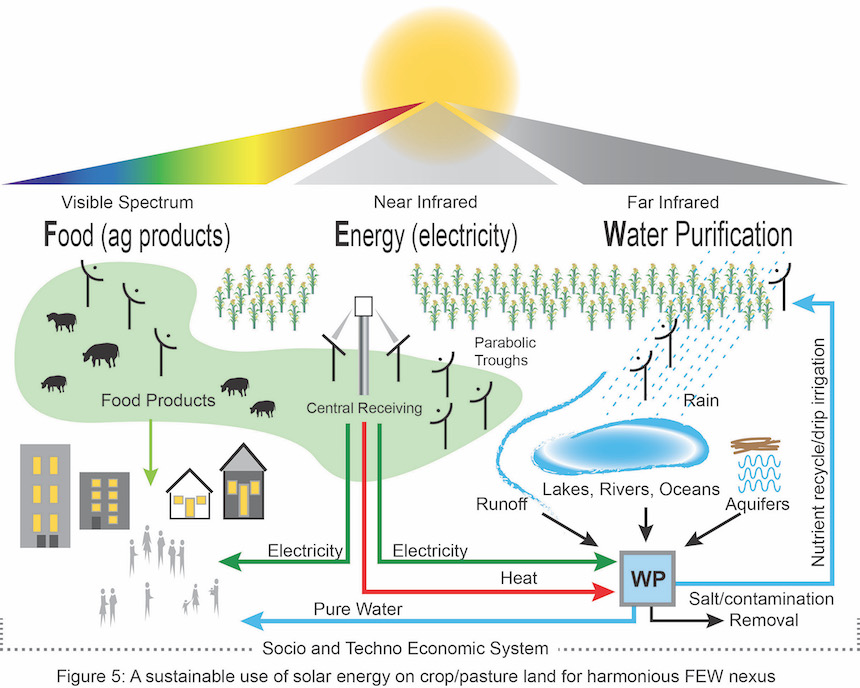
A new concept proposes to provide food, energy and water resources for the world’s growing population by combining systems that simultaneously use different parts of sunlight’s spectrum to produce crops, generate electricity, collect heat and purify water.
The world’s human population is expected to grow from seven billion to more than ten billion over the next two to three generations, leading to a “full earth” scenario.
“This increase in population, coupled with rising per capita income and associated change in consumption habits, will put unprecedented stress on food, energy and water resources,” said Rakesh Agrawal, Purdue University’s Winthrop E. Stone Distinguished Professor in the School of Chemical Engineering. “The grand challenge before us is to sustainably meet the needs of a full earth using scarcer resources, and the sun is the key energy source to achieve this goal.”
Purdue says that he is leading a team of researchers proposing a system that would use the entire solar spectrum to maximize resource production from a given land area. The concept is described in a paper appearing in the journal Scientific Reports.
The concept works by separating and harvesting the three specific segments of the solar spectrum that are best suited to facilitate the production of food, energy and clean water. In current practices, much of this spectrum is wasted because all of the sunlight falling on a given spot is used solely for one purpose, such as agriculture, energy production or water purification. The new approach would instead use the same land mass for all three purposes simultaneously through innovative technologies that split the spectrum into three segments and efficiently harvest sunlight.
A typical photovoltaic panel, when installed on farmland, casts a shadow and dramatically reduces plant growth and crop yield from the shadowed area. The proposed photovoltaic designs transmit photons responsible for plant growth while reflecting remaining photons in the solar spectrum to specially-designed solar cells to generate electricity and collect heat for energy recovery and water purification.
“The advantage of our proposed solution is clear,” Agrawal said. “With the three-way split, the entire spectrum is judiciously used for the production of food, energy and water resources.”
Solar spectrum splitting to maximize electric power generation and heat recovery is well known, coauthor Alam said.
“However, its feasibility in the context of food, energy and water resources on the same land has never been reported,” he said. “Here, we not only consider this possibility and develop systems to achieve this goal, but also through modeling show the vast unexplored potential of such a system toward meeting the food, energy and water needs for a full earth.”
The proposed system could create solar-powered, self-sufficient communities – a major step toward full-earth preparedness, Bermel said.
“Furthermore, implementing this approach across agricultural land areas could supply extra electricity to the power grid, as well as freshwater supplies to other areas in need, thus improving global resilience,” he said.
Water from sources such as underground wells, oceans, rivers, lakes, ponds, and field runoff would enter water purification units powered by the heat and electricity generated from sunlight. The purified water would then be used for irrigation or urban needs. Any salts or contamination-rich water leaving the water purification units would be sent for further processing, recycling or disposal.
“A major feature is the ability to produce food, energy and water resources locally without interfering with agricultural production, which will be increasingly important, as expected population growth will require increased dedication of land resources to agriculture,” Agrawal said. “At the same time, the local generation of electricity will allow the use of microgrids in villages and provide a new paradigm for electricity generation and distribution. Local generation of power and clean water also is expected to reduce the long-distance transmission losses inherent in any power supply grid system.”
— Read more in Emre Gençer et al., “Directing solar photons to sustainably meet food, energy, and water needs,” Scientific Reports 7, Article number: 3133 (9 June 2017) (doi:10.1038/s41598-017-03437-x)

